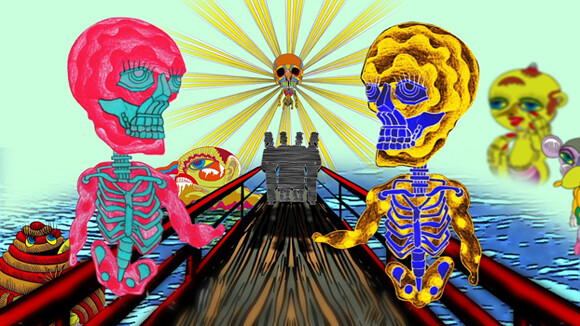Keiichi Tanaami
New Animation and Drawings
7 July–5 August 2012
Opening: 7 July, 18–20
NANZUKA
Shibuya Ibis Bldg. B1F
2-17-3 Shibuya
Shibuya-ku, Tokyo
T +81 3 3400 0075
info@nug.jp
Nanzuka is pleased to announce a solo exhibition of animation and drawings by Keiichi Tanaami. The exhibition will be comprised of two parts: the new digital animation Red Colored Bridge, and the enormous collection of drawings considered to be the root of Tanaami’s creative work.
Keiichi Tanaami was born in Tokyo in 1936 and graduated from Musashino Art University. A one-of-a-kind artist active since the 1960s as a graphic designer and illustrator, Tanaami is an artist who does not heed the boundaries of media and genre but instead traverses them. Tanaami received the grand prize from the Japan Advertising Artists Club in 1958 while still a student, and after graduating in the mid-’60s was baptized by psychedelic culture and Pop Art. He has since worked in a wide range of media including film, silkscreen, painting, and sculpture. A run-in with Andy Warhol in the late ’60s became one of his largest inspirations, and he has continued to this day to challenge in experimental ways the major issues within contemporary art, such as art and design, art and product, and the relation between art and daily life.
Tanaami’s work in film has a long history. Since showing his first color animation Marionettes in Masks (35mm) at the Sogetsu Animation Festival held in 1965, he has shown more than 50 animations and experimental films. Tanaami’s admiration for film is influenced by his respect for Osamu Tezuka’s exploitation of the commercialization of so-called “moving pictures,” as well as by the movements of vanguard artist contemporaries such as Andy Warhol and Jonas Mekas. Film presented new possibilities for molding time, traversing media, and approaching as large an audience as possible, and was the most suitable media for Tanaami’s artistic image. That Tabaimo is among the pupils Tanaami turned out is also an indication of the importance he places on “film as art.”
Red Colored Bridge, the new digital animation to be shown at the upcoming exhibition, represents Tanaami’s various thoughts regarding “the bridge as a crossing point that passes between this world and the next.” As Tanaami explains, “For me, the profound and mystical world of the bridge poses a complex, haunting riddle. If the bridge is what separates this world from the afterworld, the border between the mundane and the divine, it must also be a place of meeting. Who is singing that song, faintly echoing from the other side of the bridge? I want to find out. I will always be intrigued by the infinite darkness that spreads out quietly beneath the bridge, the bottomless mystery hidden within that mystical, strange space.” The red bridge has, accordingly, been the driving force behind Tanaami’s imagination in recent years. His works contain, for example, many motifs drawn from Tanaami’s childhood experience of war. Glowing grotesque creatures are personifications of bombs and the light from their explosions. Beams of light stretching outward recall the searchlights of Japanese troops keeping watch for American bomber planes. Skeletal monsters that appear in his works represent both those injured in the war as well as ourselves, unaware of the true horrors of war. Goldfish-like characters also often appear in Tanami’s work. This motif is deeply tied to a scene from Tanaami’s memory etched permanently in his mind—the image of light from the bombs reflecting off the scales of his grandfather’s goldfish. Pine trees, seemingly pregnant with animal-like life forms, are based on hallucinations Tanaami witnessed when he nearly died from a pulminary edema at age 44.
The inimitable characters and motifs produced by Tanaami have their roots in the drawings Tanaami has been creating on a daily basis for half a century. The upcoming exhibition will show as many of the enormous number of drawings created from 1980 up to the present as possible, covering a wide range of work from Tanaami’s personal diary-like drawing books and animation storyboards to experimental line drawings and original sketches of characters that appear in his recent paintings. Tanaami has said that “drawing is a blissful time,” but for Tanaami, who puts in a solid eight hours of creative work each day in his studio even today, drawing, like eating, is his bread and butter.
“Drawing is for me perhaps the same as eating. When looking upon a colorful dinner table, that sensation of contentment and happiness when the empty stomach is filled, for a moment one’s insignificant problems disappear. Line drawings unleashed from the brush fly at their own will through space independent of my own volition, and display a development beyond my imagination. Looking at the diverse drawings scattered before me, I am filled with the happy feeling of looking upon a feast-laden dining table.”
There will be an opening reception with the artist present on 7 July from 18–20.

